Glide into the transformative world of kayaking with three essential steps that will turn your first camping adventure into an unforgettable water-bound journey. Master the fundamental “wet exit” in shallow, calm waters before attempting any extended paddles – it’s your safety foundation and confidence builder. Choose a stable, beginner-friendly recreational kayak with a cockpit wide enough for easy entry and exit, particularly important when navigating Ontario’s diverse waterways. Practice the basic forward stroke close to shore, keeping your torso rotation fluid and your arms relatively straight, letting your core do the work rather than your shoulders. Within a single afternoon of focused practice, you’ll transform from tentative beginner to confident paddler, ready to explore the pristine lakes and gentle rivers that make Ontario’s wilderness so spectacular.
Essential Kayaking Gear for Campers
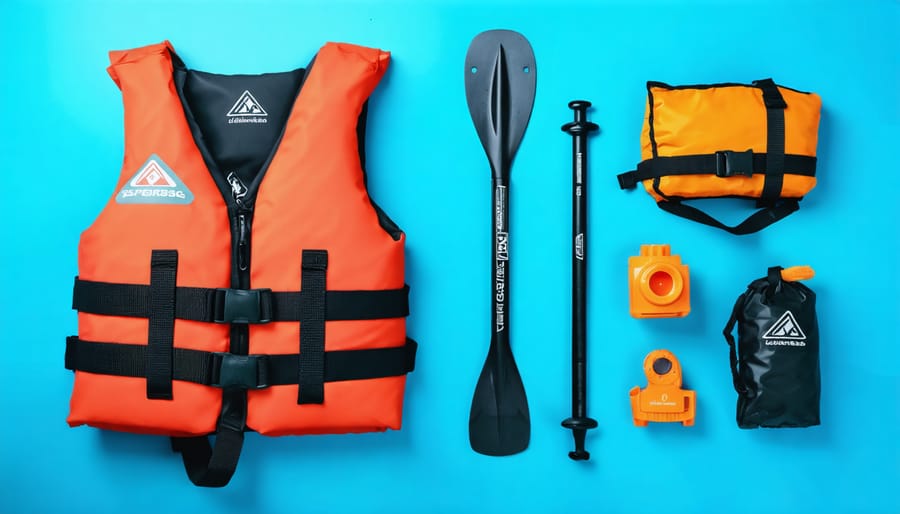
Must-Have Safety Equipment
Before hitting the water, you’ll need to gear up with essential safety equipment – it’s not just good practice, it’s the law in Ontario! The most crucial piece is a properly fitting Personal Flotation Device (PFD). While those bright orange life jackets might bring back memories of summer camp, modern PFDs are comfortable, stylish, and designed for paddling.
Every kayaker must carry a sound-signaling device, like a whistle, to alert others in case of emergency. Make it easily accessible by attaching it to your PFD. You’ll also need a buoyant heaving line (at least 15 meters long) and a bailer or pump to remove water from your kayak.
If you’re paddling after sunset or in low visibility conditions, pack a waterproof flashlight or headlamp – it’s required by law. Pro tip: even if you’re planning a daytime paddle, tuck one in your dry bag just in case.
Speaking of dry bags, while not legally required, they’re invaluable for protecting your phone, car keys, and other essentials. A first-aid kit is another must-have that could make a world of difference when you’re out on the water.
Kayak Types for Camping
When it comes to camping with kayaks, you’ve got two main options: recreational kayaks and touring kayaks. Recreational kayaks are shorter, wider, and more stable – perfect for beginners and casual paddlers. They’re also typically more affordable and easier to transport, making them a popular choice for weekend camping trips.
Touring kayaks, on the other hand, are longer and sleeker, offering more storage space and better tracking through the water. If you’re planning multi-day camping adventures, these boats are ideal as they have watertight compartments for keeping your gear dry.
For first-timers, I recommend renting before buying. Many Ontario provincial parks and outfitters offer kayak rentals right at popular camping spots, letting you test different styles without the commitment. If you decide to purchase, consider a versatile recreational kayak around 10-12 feet long – it’ll serve you well for both day trips and overnight adventures.
Pro tip: Look for kayaks with adjustable foot pegs and comfortable seating if you’re planning longer paddling sessions. And don’t forget to check the weight capacity – you’ll need enough room for both yourself and your camping gear!
Basic Kayaking Skills for Beginners
Getting In and Out Safely
Getting in and out of your kayak might seem tricky at first, but with the right technique, it becomes second nature. When launching from shore, place your kayak perpendicular to the waterline with the bow facing the water. Straddle the kayak behind the cockpit, keeping your weight centered. Lower yourself into the seat while using both hands on the sides of the cockpit for support, then smoothly swing your legs in one at a time.
For dock launches, sit on the edge with your legs dangling over the kayak’s cockpit. Place your paddle behind you on the dock for support, then use your arms to lower yourself into the seat while sliding your legs in. The key is keeping your weight centered and movements controlled.
When returning to shore, paddle parallel to the shoreline in shallow water. Exit by reversing your entry motion – swing one leg out at a time, then push yourself up to a standing position. For dock exits, grab the dock edge, push up with both arms, and smoothly slide onto the dock.
Pro tip: Practice these movements in shallow water first, where you can easily stand if needed. Having a friend nearby to stabilize your kayak can also boost your confidence while learning these techniques.
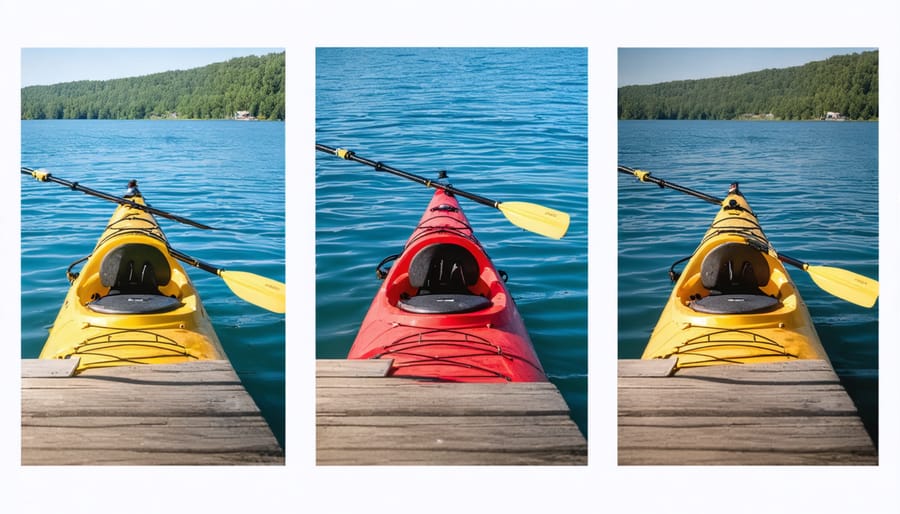
Paddling Techniques
Mastering basic paddle strokes will help you control your kayak with confidence. Start with the forward stroke – your main means of propulsion. Hold your paddle with hands shoulder-width apart, keeping your torso straight and core engaged. Dip one blade into the water near your feet and pull it back alongside the kayak in a smooth motion.
The sweep stroke helps you turn your kayak. Make a wide arc with your paddle from the front of the boat to the back, keeping the blade fully submerged. Sweep on the right to turn left, and vice versa. For quick turns, try the draw stroke by reaching out to the side and pulling the water toward your kayak.
To stop or reverse, use the back stroke by paddling backward. For stability in rough waters, practice the low brace – a defensive stroke where you hold your paddle parallel to the water’s surface and slap it down to prevent tipping.
Remember to keep your arms relatively straight and use your torso rotation for power rather than just your arms. This technique not only improves efficiency but also prevents fatigue during longer paddling sessions.
Reading Water Conditions
Before dipping your paddle in the water, it’s crucial to understand the conditions you’ll be facing. Start by checking the weather forecast – wind is particularly important for kayakers, as strong gusts can make paddling challenging for beginners. Aim for calm days with winds under 15 km/h when you’re starting out.
Look at the water’s surface: glassy conditions are ideal for learning, while small ripples are manageable but require more effort. Watch for signs of currents or rapids, which should be avoided until you’ve mastered basic skills. In Ontario’s lakes and rivers, morning typically offers the calmest conditions.
Water temperature is another vital consideration. Even on warm summer days, many of our northern waters stay cool. If the combined air and water temperature is less than 120°F (48°C), wear appropriate thermal protection. This is known as the “120-degree rule” among paddlers.
Pay attention to posted warnings and flags at beaches or boat launches. A simple way to gauge conditions is the “white cap test” – if you see white caps forming on waves, it’s best to postpone your paddling adventure for another day.
Planning Your First Kayaking Trip
Best Ontario Parks for Beginner Kayakers
Looking to dip your paddle into kayaking? Ontario’s provincial parks offer perfect launching points for beginners, with many located among Ontario’s best camping spots. Here are some top picks for novice paddlers:
Bon Echo Provincial Park stands out with its remarkably calm waters on Lake Mazinaw. The park’s outfitter offers quality rentals and basic instruction, making it ideal for first-timers. Plus, you’ll paddle alongside stunning cliff faces adorned with Indigenous pictographs!
Killarney Provincial Park’s George Lake is another gem for beginners. Its crystal-clear waters and protected bays create perfect conditions for learning. The park store rents kayaks and provides life jackets, so you don’t need to bring your own gear.
For those near the GTA, Silent Lake Provincial Park lives up to its name. With no motorized boats allowed, you’ll find peaceful waters perfect for practicing basic strokes. The beach launch area is particularly beginner-friendly, with gradual entry and helpful staff.
Local’s Tip: Visit these parks during weekdays or shoulder season (May-June or September) for fewer crowds and better rental availability. Most parks offer hourly rentals, so you can test the waters before committing to a full day. Remember to call ahead to confirm rental availability and reserve your time slot!
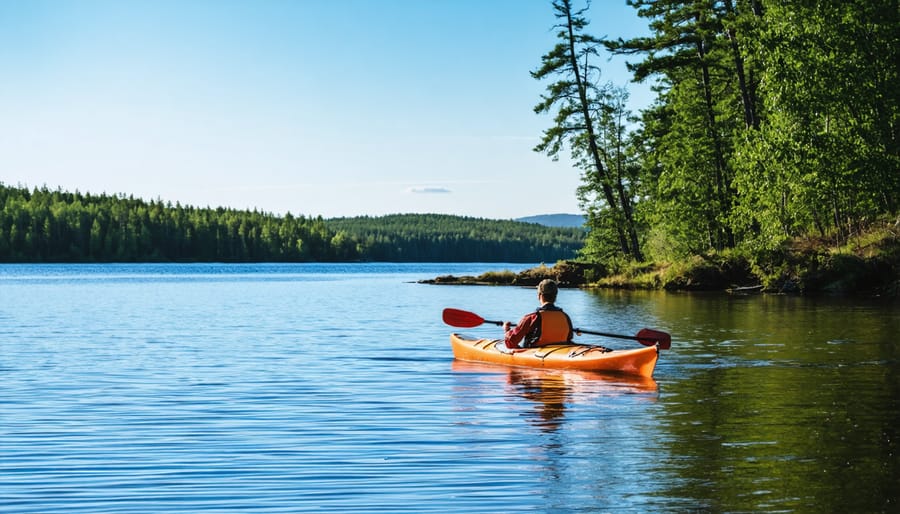
Trip Planning Tips
Combining kayaking with camping opens up incredible opportunities for wilderness exploration, but it requires careful planning and organization. When planning your camping trip, consider how you’ll transport your kayak to the campsite. If you’re renting, many Ontario parks offer on-site rentals, eliminating transportation concerns. For those bringing their own kayaks, invest in quality roof racks or a trailer, and always secure your kayak properly with appropriate straps and tie-downs.
Storage at the campsite is equally important. Keep your kayak elevated off the ground using sawhorses or a kayak stand to prevent damage and deter small animals from making it their home. When possible, store it under a tarp or bring it to your campsite’s sheltered area during severe weather.
Pack your gear in waterproof bags and containers, organizing items by priority and frequency of use. Essential kayaking gear should be easily accessible, while camping equipment can be packed more deeply. Consider using dry bags that can double as camping storage – they’re perfect for keeping clothes and electronics safe both on and off the water.
For multi-day trips, plan your route to include designated rest stops and camping areas along waterways. Many of Ontario’s provincial parks offer water-access sites specifically designed for paddlers, combining the best of both worlds – peaceful paddle-in camping with the security of maintained campsites.
Environmental Responsibility
Leave No Trace Principles
As kayakers, we have a responsibility to protect the pristine waterways we enjoy. Following eco-friendly camping practices helps ensure these natural spaces remain beautiful for future paddlers.
Always pack out what you pack in – this includes snack wrappers, water bottles, and any other items you bring along. Avoid disturbing wildlife by maintaining a respectful distance and never feeding animals. When taking breaks, choose existing landing spots rather than creating new ones that could damage shoreline vegetation.
Keep noise levels down – sound carries surprisingly well across water. Not only will this help preserve the peaceful atmosphere for other paddlers, but it also prevents disrupting local wildlife. If you need to answer nature’s call, do so at least 200 feet from any water source.
Be mindful of your wake in narrow channels or near shorelines where erosion might occur. When launching or landing your kayak, use designated areas whenever possible. If you must launch from a natural shoreline, try to minimize your impact by avoiding vegetation and fragile bank areas.
Remember, every small action counts toward preserving our beautiful Ontario waterways for generations to come.
Wildlife Awareness
Kayaking offers an incredible opportunity to observe wildlife in their natural habitat, but it’s essential to do so responsibly. Keep a respectful distance from all animals – a good rule of thumb is to stay at least 100 meters away from larger wildlife like moose, bears, or nesting birds. If animals appear agitated or change their behavior, you’re too close.
When paddling near shorelines, watch for turtles basking on logs and water birds fishing in the shallows. Remember that you’re a guest in their home. Avoid making loud noises or sudden movements that might startle wildlife. Early morning and dusk are prime viewing times, but also when animals are most active, so stay extra vigilant.
Never feed wildlife from your kayak – it’s harmful to their natural behaviors and could be dangerous for you. Keep any snacks sealed in waterproof containers to avoid attracting animals. If you encounter larger animals like moose in the water, give them plenty of space and paddle away calmly.
Take only photos and leave only ripples. Consider bringing a small pair of binoculars for better viewing while maintaining a safe distance. By practicing responsible wildlife viewing, you help preserve these wonderful encounters for future paddlers.
Combining kayaking with camping opens up a whole new world of outdoor adventures and creates memories that will last a lifetime. There’s something magical about waking up to the sound of lapping waves, brewing your morning coffee by the shore, and sliding your kayak into the misty waters as the sun rises. The skills you’ve learned as a kayaker not only enhance your camping experience but also allow you to reach secluded spots that would otherwise remain hidden from view.
As you become more comfortable with both activities, you’ll discover the joy of multi-day kayak camping trips, where every paddle stroke takes you further into Ontario’s wilderness. Pack light, respect the environment, and remember that the journey is just as important as the destination. Whether you’re gliding past towering cliffs in Killarney, exploring the countless islands of Georgian Bay, or finding your own secret cove in Algonquin Park, the combination of camping and kayaking offers an unparalleled connection with nature.
So grab your paddle, pack your tent, and embark on your own kayaking camping adventure. The waterways of Ontario are waiting to show you their wonders.


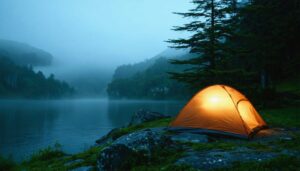




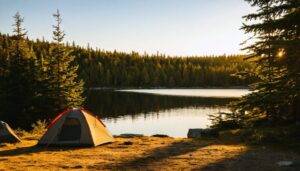


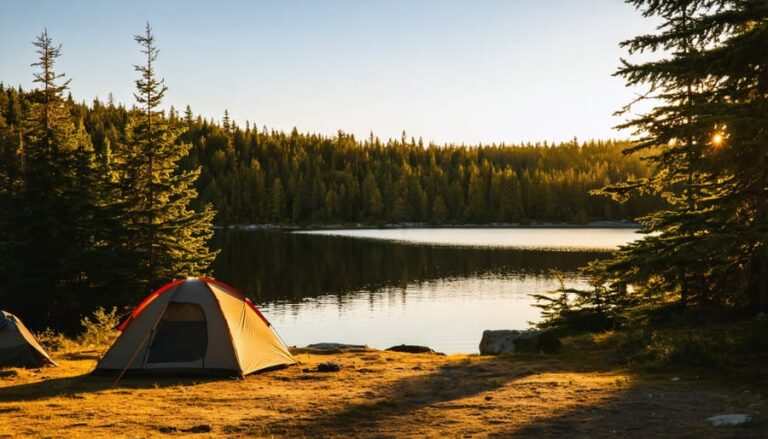
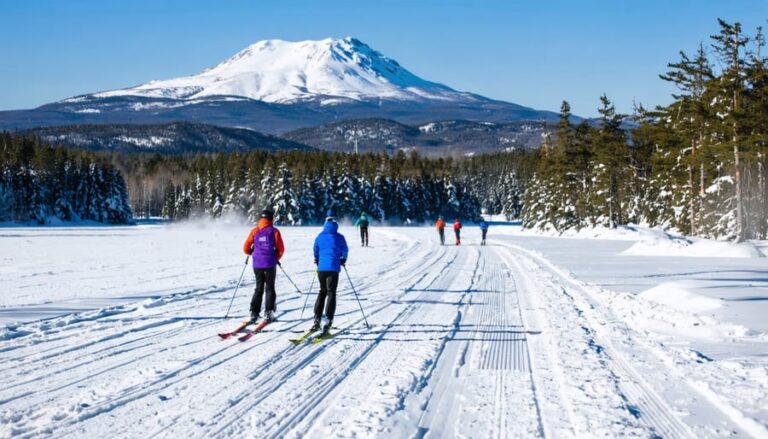


+ There are no comments
Add yours